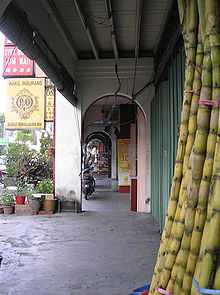Five foot way

Five foot ways (Malay: Kaki lima) are pedestrian walkways indented into the ground floor of a building from the road, so that the overhanging upper floors can provide a cover to shield pedestrians from the sun and rain. This feature can be found in many shophouses (and buildings of similar structural design) all over the world, and also in some office buildings (e.g. those along Shenton Way in Singapore). As the ground floor of most buildings are shops or eating places, the five foot ways can also function as a corridor for people to window-shop or stop by for some refreshments. As implied by name, five foot ways were intended to assume a consistent width of five feet from the absolute front to the wall and entrance defining the frontal of the inner space, but the guideline is not necessarily applied universally, as certain five foot ways are wider or narrower depending on the age, size and function of the building.[1]
In Malaysia and Singapore, five foot ways date back to the time of the Colonial Government, when Stamford Raffles included this[2] and other details in his Town Plan of 1822; the feature was eventually integral in many settlements in neighbouring British colonies, and remains a prominent element in modern architecture in Singapore, Malaysia and Brunei. Attempts in Singapore to clear the walkways of hawkers in the 1880s led to the so-called "Verandah Riots".[3]
The Malay term for "five foot way", kaki lima (literally translated as only "five foot"), is also used generally to refer to corridors or verandas, regardless of their width.
See also
- Verandah
- Portico
External links
- The Five Foot Way of Georgetown Penang
- http://www.thejakartapost.com/news/2010/12/19/the-5-feet-story-thomas-stamford-raffles.html